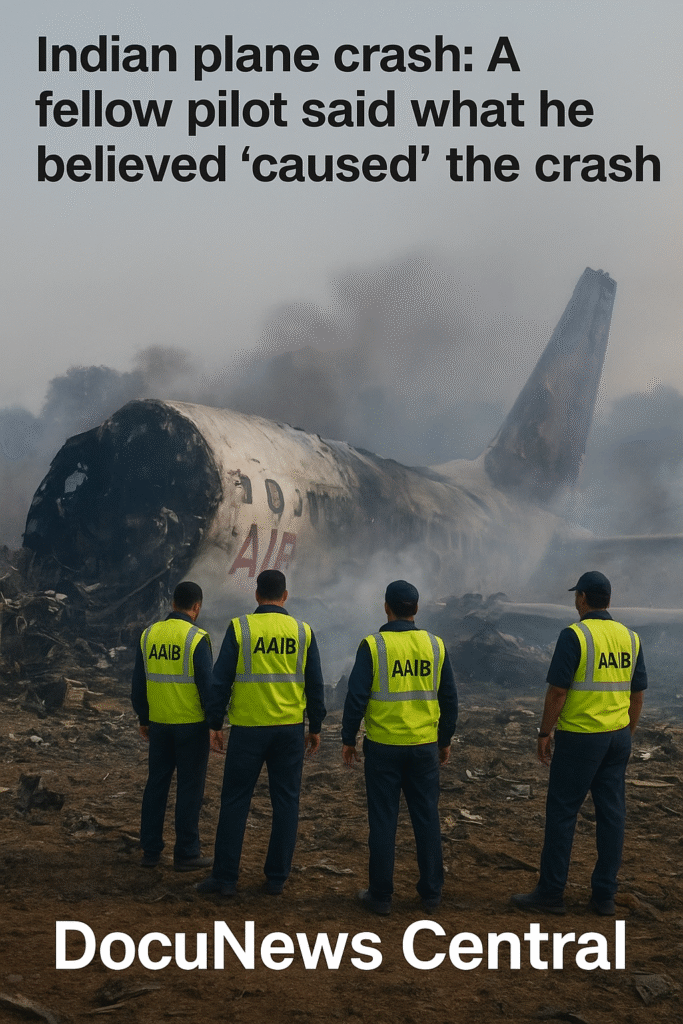

The tragic crash of Air India Flight AI 171 remains one of the most shocking aviation disasters in recent years. The aircraft, a Boeing 787 Dreamliner, went down just moments after take-off from Ahmedabad on June 12, 2025, killing all 260 people on board and several others on the ground.
As investigators continue to examine what led to the sudden loss of both engines, a new perspective has emerged. A fellow pilot, who knew the late Captain Sumeet Sabharwal personally and had flown alongside him on numerous flights, has revealed what he believes “caused” the deadly crash. His testimony offers a chilling yet thought-provoking look into what might have gone wrong that day.
The man behind the controls
Captain Sumeet Sabharwal was an experienced pilot with more than 15,000 hours of total flight time — including over 8,000 hours flying Boeing 787 Dreamliners. He was one of Air India’s most trusted and respected captains.
Colleagues recall him as calm, professional, and exceptionally disciplined. “He was a polished gentleman and an outstanding pilot,” said one former colleague, Captain Manmath Routray. “He never cut corners and always kept his composure in the cockpit.”
That reputation is precisely what makes this tragedy so difficult for many to understand.
What happened on that fateful morning
Flight AI 171 departed from Sardar Vallabhbhai Patel International Airport in Ahmedabad, bound for London Gatwick. Barely a minute into the flight, the aircraft began to lose altitude and crashed near the city’s outskirts, bursting into flames.
Flight data later showed that both engines lost power almost simultaneously. Investigators from the Aircraft Accident Investigation Bureau (AAIB) found that both fuel control switches — the levers that regulate fuel flow to each engine — had been moved from “RUN” to “CUTOFF” within one second of each other.
This single action effectively shut off both engines, depriving them of fuel. Although the switches were soon returned to “RUN”, the aircraft had already lost lift and altitude. The pilots had less than 30 seconds before the plane hit the ground.
Investigation findings so far
The AAIB’s preliminary report, released in July 2025, confirmed that there was no sign of explosion, sabotage, or bird strike. The focus quickly shifted to whether the movement of the fuel switches was the result of human error, a mechanical fault, or deliberate action.
Boeing engineers and Indian aviation regulators are now investigating the cockpit’s electrical and hydraulic systems to determine whether an internal malfunction could have caused the fuel supply to be cut unintentionally.
Experts noted that the switches are designed to prevent accidental engagement, meaning it would typically require deliberate physical movement to flip both from “RUN” to “CUTOFF.”
A fellow pilot breaks his silence
Amid speculation, one of Captain Sabharwal’s long-time colleagues has stepped forward with his own perspective. The unnamed pilot said he flew with Sabharwal on several international routes and had known him personally for years.
“I knew Sumeet very well,” he said. “He was not careless, not reckless, and never impulsive. He followed procedures with almost military precision. That’s why, when I saw the report about both fuel switches being turned off, I couldn’t believe it was an accident.”
According to him, such a movement would have required two deliberate, separate actions — something that an experienced pilot would not do unintentionally, especially during take-off.
What the pilot believes “caused” the crash
The pilot said he believed Captain Sabharwal might have intentionally cut the engines, possibly due to personal distress, fatigue, or a sudden emotional breakdown.
He clarified that this was only his personal belief, not an accusation. “If he did it, it wasn’t because he wanted to hurt anyone. It might have been a moment of unbearable pressure or confusion. We’ll never know for sure,” he said.
He also revealed that in the months before the crash, Sabharwal seemed quieter and more withdrawn than usual. “He was always polite, but lately, he had a lot on his mind. He looked tired — like he hadn’t been resting well.”
Pushback from pilot unions
Air India’s pilot associations have condemned speculation about pilot suicide or intentional sabotage, calling such theories “unverified and unfair.”
“It is deeply irresponsible to link this tragedy to mental health or intentional action without conclusive evidence. We urge investigators and the media to rely on verified data, not speculation,” the Indian Commercial Pilots’ Association said.
They stressed that pilot fatigue, technical malfunctions, and design factors should all be examined with equal seriousness before conclusions are made.
Technical angles still under review
- Electrical malfunction – A potential short circuit might have sent incorrect signals to the fuel system.
- Maintenance error – A calibration issue in the fuel control assembly could have caused the switches to misbehave.
- Design flaw – The 787’s cockpit design might allow rare simultaneous switch movement.
- Sensor failure – A system misread could have triggered an automatic safety response.
Until the final AAIB report is released, none of these possibilities can be dismissed.
A broader human story
Aviation specialists note that modern pilots face enormous psychological and physical strain. Long hours, fatigue, and constant responsibility can weigh heavily — even on the most experienced aviators.
“Pilots are trained to manage emergencies, but not always their own emotions,” said an aviation psychologist. “We need to protect their mental health the same way we protect passengers’ safety.”
The colleague’s emotional reflection
Despite his speculation, the pilot who spoke out expressed sadness rather than judgment. “Sumeet was a friend. If he did something that day, it was out of pain, not neglect,” he said.
He urged the public not to turn the tragedy into gossip or blame. “Everyone wants answers, but we must let the evidence speak. What matters most is the truth — for the families, for the crew, and for everyone who flies.”
Lessons from a tragedy
The Air India crash of June 2025 has raised difficult but necessary questions about aircraft safety and human factors in aviation.
- Design improvements: Double-confirmation systems for critical switches like fuel controls.
- Training upgrades: Stress-based simulations during take-off emergencies.
- Fatigue management: Stricter rest periods for long-haul crews.
- Transparent investigations: Public access to final reports to rebuild trust.
Families demand independent probe
Families of the victims, along with Captain Sabharwal’s father, have called for an independent judicial inquiry into the crash. They insist that only a transparent, international investigation will bring closure.
Their petition is currently before the Supreme Court of India, requesting an unbiased review of both technical data and cockpit recordings.
Waiting for the final truth
As of October 2025, the official cause of the Air India Flight AI 171 disaster remains undetermined. The final AAIB report is expected later this year, but experts warn that the truth may be complex, combining both mechanical and human elements.
Whether Captain Sabharwal’s final moments were defined by confusion, failure, or despair, one thing is certain — his loss has left a profound mark on the aviation community.
“We may never know exactly what happened in that cockpit,” the fellow pilot concluded. “But we can learn from it — and make sure it never happens again.”
Related Articles:
- Air India Flight AI171: Full investigation update
- Aviation safety lessons from recent global crashes
- Pilot fatigue: How it affects flight safety
© 2025 DocuNews Central | Breaking News. Verified Stories.









It really hurts all of us